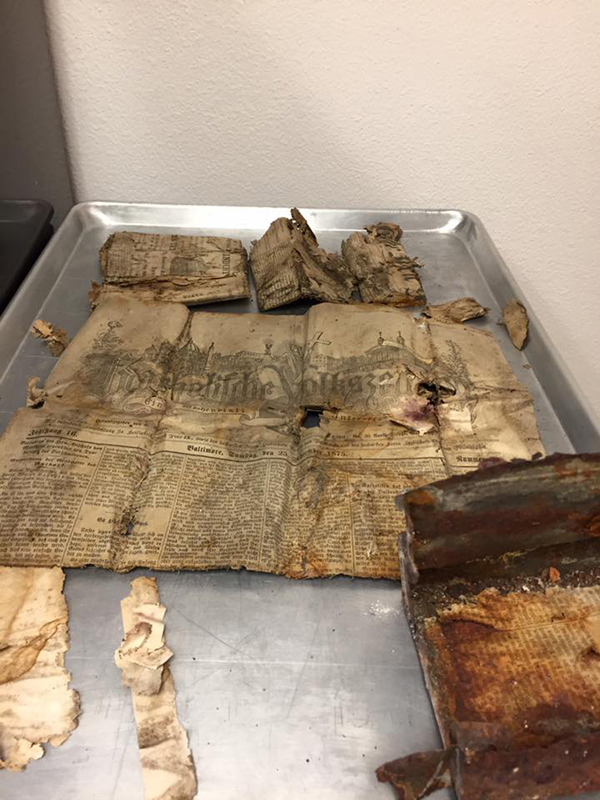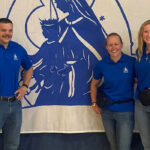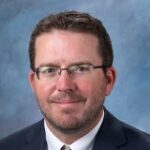By Lindsay Steele
The Catholic Messenger
The Catholic community in Solon is known for its Czech roots. So when a time capsule from 1875 revealed a German-language newspaper, everyone was puzzled.
“It’s a mystery,” St. Mary-Solon’s pastor, Father Tim Sheedy, said at the time.

These are the contents of the 1875 time capsule from St. Mary Parish in Solon.
St. Mary’s is finishing up the process of demolishing its old church in order to expand the adjacent parish cemetery. The parish has been in its current location since 1998. The old church was used for religious education classes until the basement classrooms were finished in the new structure about five years ago.
Parishioners were unaware of the time capsule until they pulled it out of the cornerstone July 26. “It was out of sight, out of mind,” Fr. Sheedy said. But since cornerstones of that era generally contain artifacts of some kind, the parish asked the contractors to preserve it during the demolition process.
The St. Mary time capsule predates the Diocese of Davenport by six years, and The Catholic Messenger by seven years. The time capsule contained the now out-of-print independent German-language newspaper, Katholische Volkszeitung (Catholic People’s Newspaper) of Baltimore, three other newspapers and what appears to be fragments of a fifth newspaper. Damage and rust have rendered all but the German paper illegible, although one of the papers appears to be the New York Tablet, the official newspaper of the Diocese of Brooklyn, Fr. Sheedy said.
The presence of the German paper is perhaps more surprising considering that the written histories of the parishes that formed the current parish — St. Mary and Ss. Peter & Paul — do not identify as having German origins. Ss. Peter & Paul Parish, established in 1861, was founded by Bohemian (Czech) immigrants. The heritage of St. Mary’s is not as well documented, but parish history books reveal Irish, Scottish and English names among early members and pastors.
In an effort to try to solve the mysteries of the time capsule, The Catholic Messenger contacted local experts and researched census information.
Dave Muhlena, library director at the National Czech & Slovak Museum & Library in Cedar Rapids, Iowa, said that while some of the Czechs in Solon may have subscribed to the German Catholic newspaper, it would have been unlikely. Former St. Mary’s pastor Father Jim Vrba, who is of Czech heritage, noted that the early documents at Ss. Peter & Paul are in Czech.
A more likely scenario is that some German Catholics lived in Solon at the time. Census records from 1885 show a large number of German immigrants in Solon. Their numbers are comparable to the Czech presence in the community at the time. American-born individuals with Irish, Scottish and English surnames round out the census, though in smaller numbers than the Germans and Czechs.
While knowing the languages of the other newspapers in the time capsule would have painted a clearer picture of its message and the origins of the founding members, Muhlena believes it’s likely that the time capsule represented the parish’s desire to be inclusive of different ethnic backgrounds. At the time, it was common for immigrants to form separate churches or missions based on their ethnicity or language, though the contents of the time capsule may indicate the parish was multi-ethnic in nature.
Only the people who put together the time capsule know for sure what the contents actually represent. Muhlena said, “We have clues, it’s just trying to connect the dots of who founded this faith community.”
Repurposing the old St. Mary Church and property
The old St. Mary’s church, which is adjacent to the parish cemetery in Solon, is being demolished to make room for more grave sites. The parish hopes to place a few benches and a statue of Mary in the future to offer people a place to pray and reflect.
The stained glass windows are currently in storage. Parishioners were invited to take what was left of the non-sacred items at the church. Additionally, contractors saved 1,000 bricks; 200 will be sold by youth group members to benefit the youth ministry program. The other 800 bricks will be used by an Eagle Scout who is building a rosary garden behind the current St. Mary Church. If any bricks are available after that project, they will be available to those who would like to take home additional bricks.











